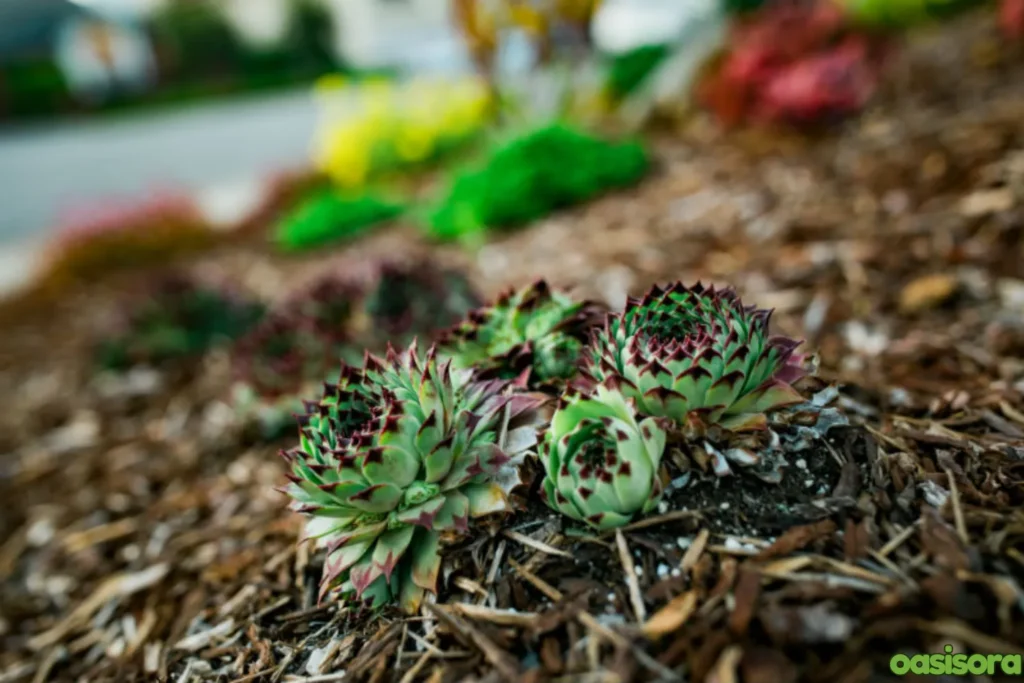
People who like to add plants with distinctive shapes to their decor are starting to include succulents to beautify their exteriors. Outdoor Succulent Garden Ideas involve planting them to create a green wall or arranging them in little pots over your garden area.
These different plants are helpful, eco-friendly, and need less maintenance. As they are resistant to drought, they generally grow everywhere. Let’s discuss the powerful strategies for growing succulents in your outdoor places to create a healthy and wonderful environment.
What is an Outdoor Succulent Garden?
An outer space where decorative succulent plants flourish is called a succulent garden. In the southern regions of the United States, where low-water landscapes are required, succulent gardens are most common. Such plants can adapt to a variety of conditions with optimal care. Many are Ideal for desert or dry areas, while several forms are also favorable to low temperatures. They look attractive due to their different colorful plants, shapes, and textures.
The most common species are euphorbia, stylish dasylirion, and aeonium. Arrange a dasylirion for the backyard of your garden as it looks like a palm. Since euphorbia and aeonium thrive closer to the ground, they should be planted more toward the front. Euphorbia appears like a cactus more than an aeonium, which grows into a flower.
Before upgrading your outdoor garden to include an entirely separate succulent landscape, you may put them among your current plants. These plants can grow in several kinds of soils and require less water. Thus, they are ideal for drought-resistant areas. For its efficient growth, arrange for proper drainage to avoid root rot.
Water the exterior succulent garden once a week in a low-rainfall area. However, potted plants might need more water. As they are durable they are the perfect choice for sustainable and low-maintenance gardening.
Benefits of Having an Outdoor Succulent Garden
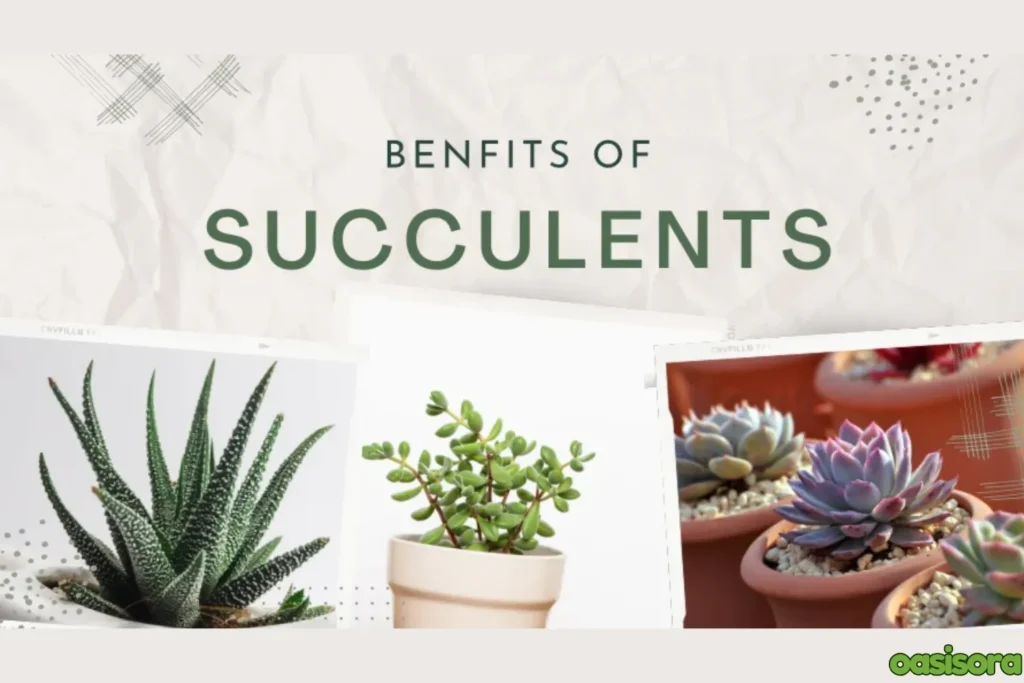
Succulents
As they conserve water in their leaves these plants are highly advantageous for dry regions, due to their low requirement for regular watering. Let’s review the positive aspects of outdoor succulent garden ideas:
- These plants survive in high temperatures with very little care and flourish in hot, dry areas.
- Succulents deliver your yard a colorful, organized appearance by holding both their form and color throughout all the seasons.
- They are a practical option for sustainable gardening due to their durability, low water consumption, and pleasing appearance.
- Succulent gardening can assist you individually in parallel with the environment. For instance, Aloe is a plant with medical properties. Use it appropriately to tackle issues like burns, cuts, and bruises. It also serves as to cure for fever, gastrointestinal disorders, and Osteoarthritis.
- According to a study in the Journal of the American Medical Association, these plant make people feel comfortable and healthy. Vitamins A, B, and C are plentiful in yucca. Thus, many people use it as tea.
Planning and Designing Your Outdoor Succulent Garden
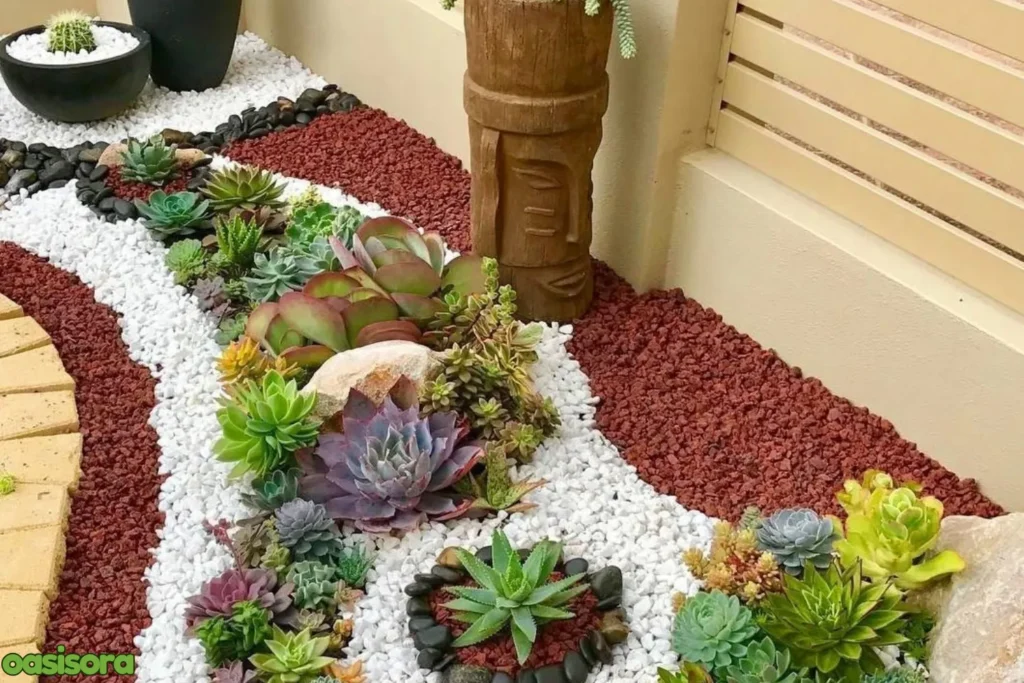
Designing idea Outdoor Succulent Garden
Since succulent gardens need very little attention, you’re curious about learning how to set up one. With proper supplies, developing a succulent garden at home is quite simple. Heatwaves can kill certain succulents. For information on finding out which succulents can perform best in your location, check your plant hardiness zone. In specific areas, certain plants will thrive more than others.
You have to identify the perfect location for your succulent garden before getting plants to stay ahead of yourself. Assessing the size of the space and how much sunlight it will receive allows you to decide the types of succulents that can prosper there and the amount to purchase.
Different succulents need varying quantities of sun and shade. While some succulents prefer full light, some enjoy shade, and yet others need low sun. For example, aloe, aeoniums, and agave demand lots of sunshine, snake plants and jade plants can withstand moderate shade.
All of your plants are still in their pots, it can be much simpler to rearrange them for a more visually pleasing arrangement than once you transplant them. Arrange tall plants at the back and the small ones in front of your yard for a more wonderful sight. Select a main plant or decorative rock, or a stunning container arrangement for attraction. Mix different varieties for colorful structures.
After you’ve placed your plants, you’re ready to go to customize your succulent garden and become happy with the layout. For narrow spaces, use hanging plants, raised beds, or plant container groups. Use stones and wood to create a desert-inspired scenery or a rocky garden in large yards.
For straightforward arrangements to apply outdoor succulent garden ideas and creative versatility, use potted displays or include succulents in raised beds for developing courtyard gardens.
Choosing the Right Succulents for Your Garden
Your environmental conditions, the space at hand, and the selected style will all affect your succulent selection process. To construct a garden that is both beautiful and growing, use a variety of forms, colors, and sizes. Here are some important types that are favorable for your outdoors.
1. Agave
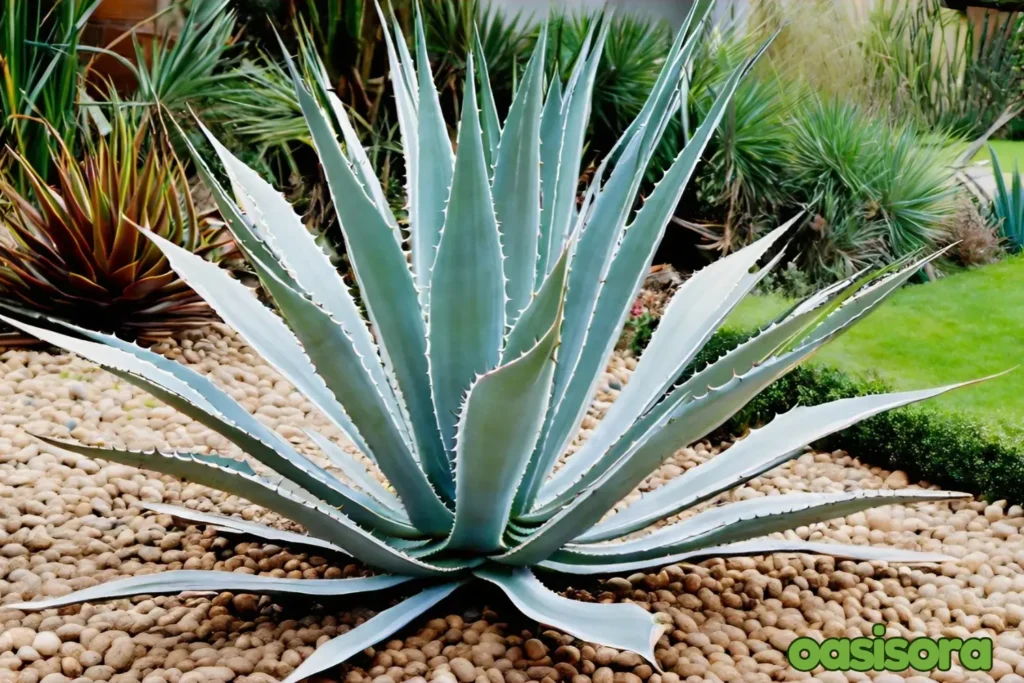
Agave Plant
Agaves occur in a range of sizes, from tiny examples that grow to be 1-2 feet tall and great for pots to huge plants that are several feet wide and tall. Except for Agave attenuata, its dense and fibrous leaves grow in a rosette pattern and frequently become hooked along the margins and end with a sharp point.
They differ in color from grey and greenish to those with reddish or blue undertones, and some, like Agave americana, are patterned with white or yellow. While most agaves like the sun, some can withstand low temperatures.
2. Aloe
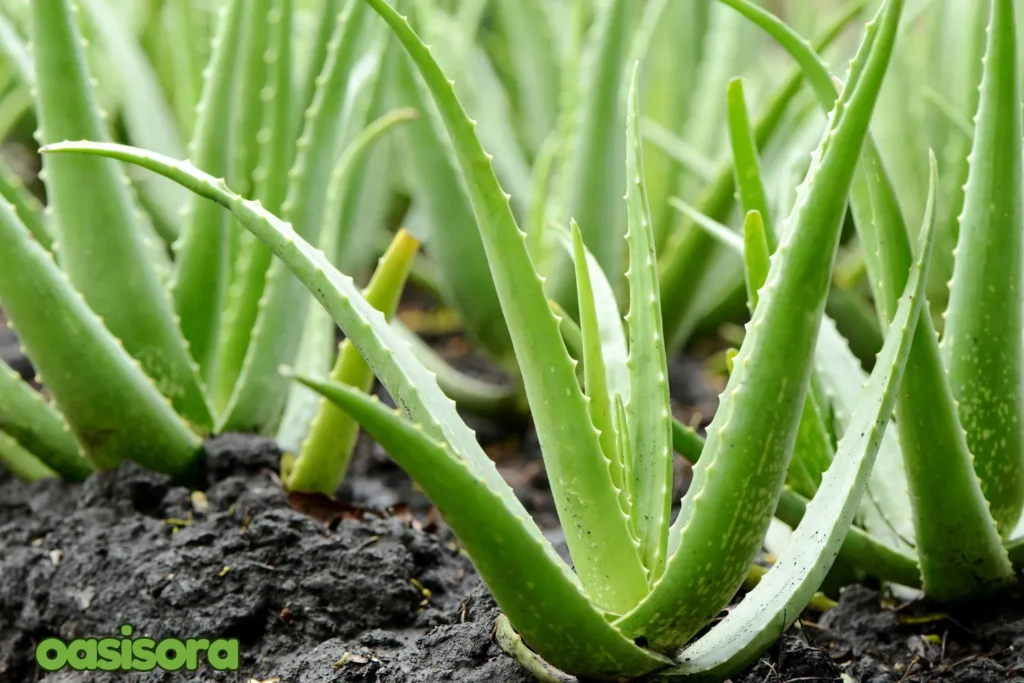
Aloe Plant
Aloe plants can be just a few inches tall or as high as twenty feet. Some aloe leaflets include marginal teeth, though they are not as sharp as the agave’s barbs. Aloe’s gel-filled leaves emerge in a rosette form. They bloom with tall stalks of flowers that have petals mostly sparkling orange, red, or yellow, from mid-winter to summer. Tiny, container-sized aloes can easily be set in indoor areas of cooler regions.
3. Echeveria
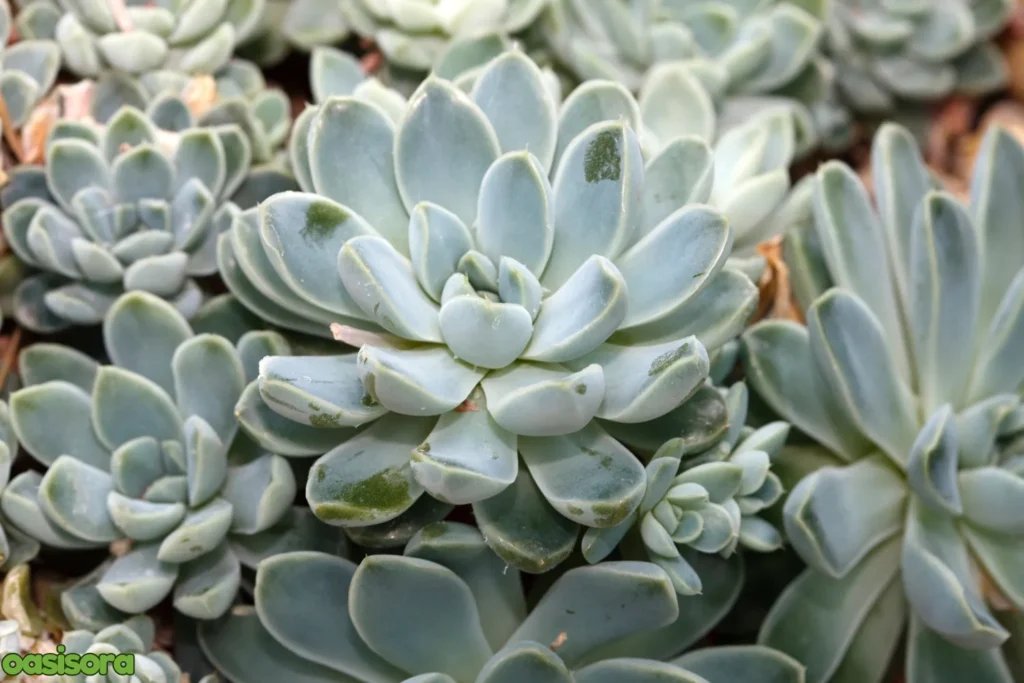
Echeveria Plant
It’s challenging to select your favorite one amongst Echeveria’s various kinds, shades, and sizes. Many of them exist in rosette form, having different shades like intense pink, deep blue, orange, and green, along with variations. Rough, powdery, or smooth leaf textures further increase its quality.
4. Crassula
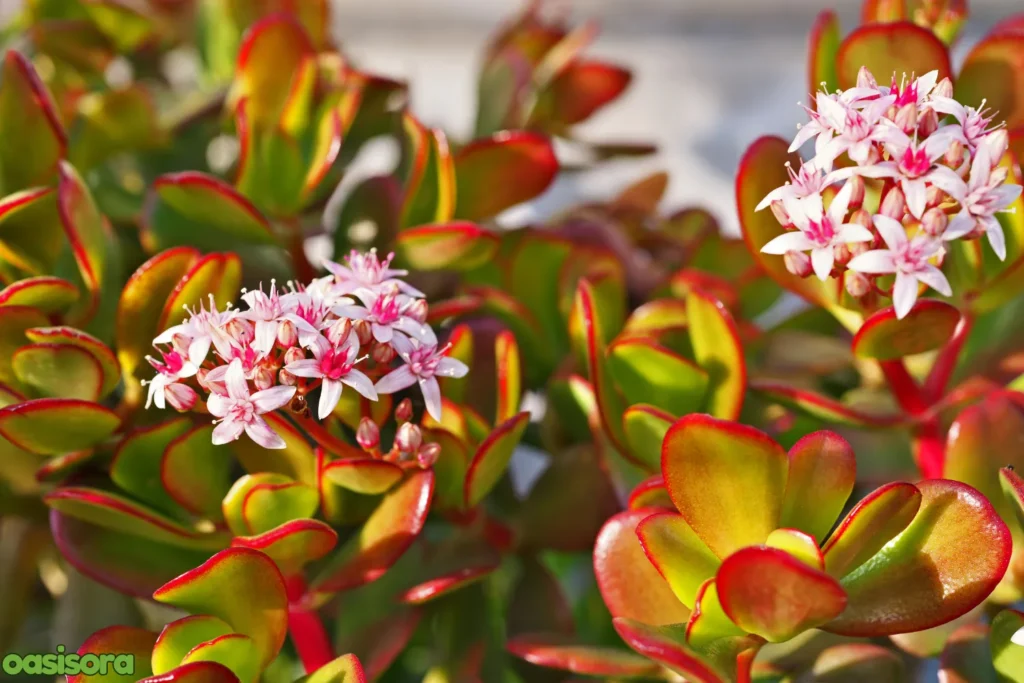
Crassula ovata jade plant
The jade plant, or Crassula ovata, exists in green and grey, some with red or yellow borders having glossy leaves that deliver a stunning look. Although they can withstand outside cooler climates, they can also survive as indoor plants. When cultivated inside, mature plants seldom blossom, though they will sometimes generate masses of tiny pink or white flowers.
5. Stonecrop or Sedum
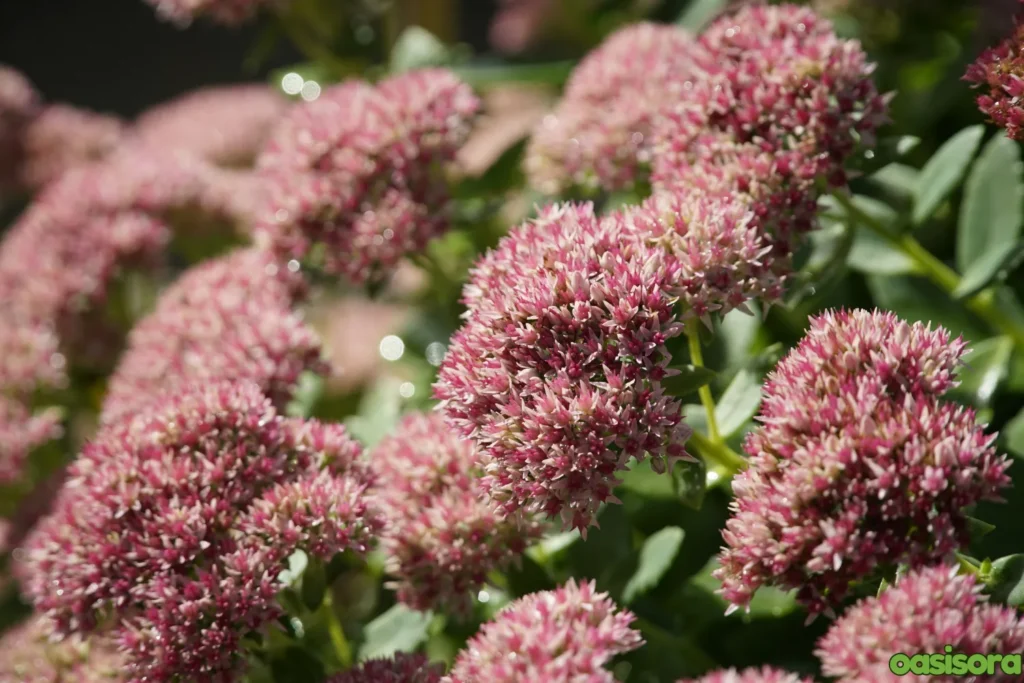
Stonecrop or Sedum
Tiny forms of Sedum and Hylotelephium are commonly referred to as stonecrops and prosper in sandy environments and sunny gaps is stone walls. Certain varieties include little, lavish blossoms that often grow in a variety of hues. Some species survive in summertime and can withstand temperature variations below freezing, while others are more resistant to high temperatures than cold.
6. Euphorbia
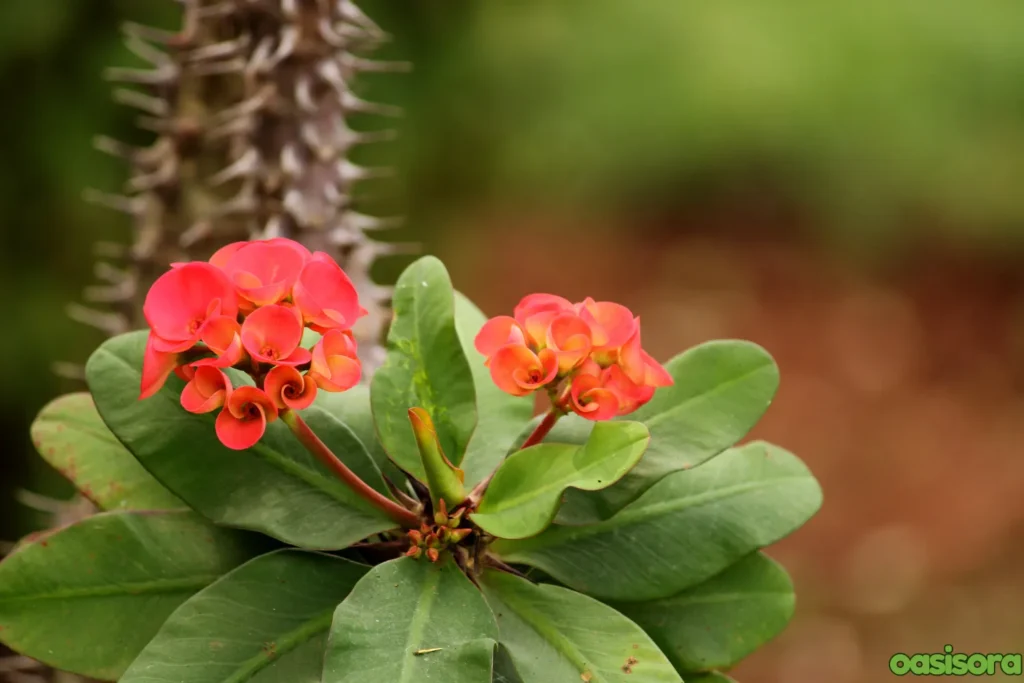
Euphorbia
500 of the over 2000 species in this vast group are succulents and ideal to use for outdoor succulent garden ideas. A harmful milky substance in certain types and undesirable to the skin in others is the basic element. Certain plants are quite similar to cacti and are equally efficient at storing water. They range significantly in size from 1-2 inches to 30-inch plants.
7. Yucca
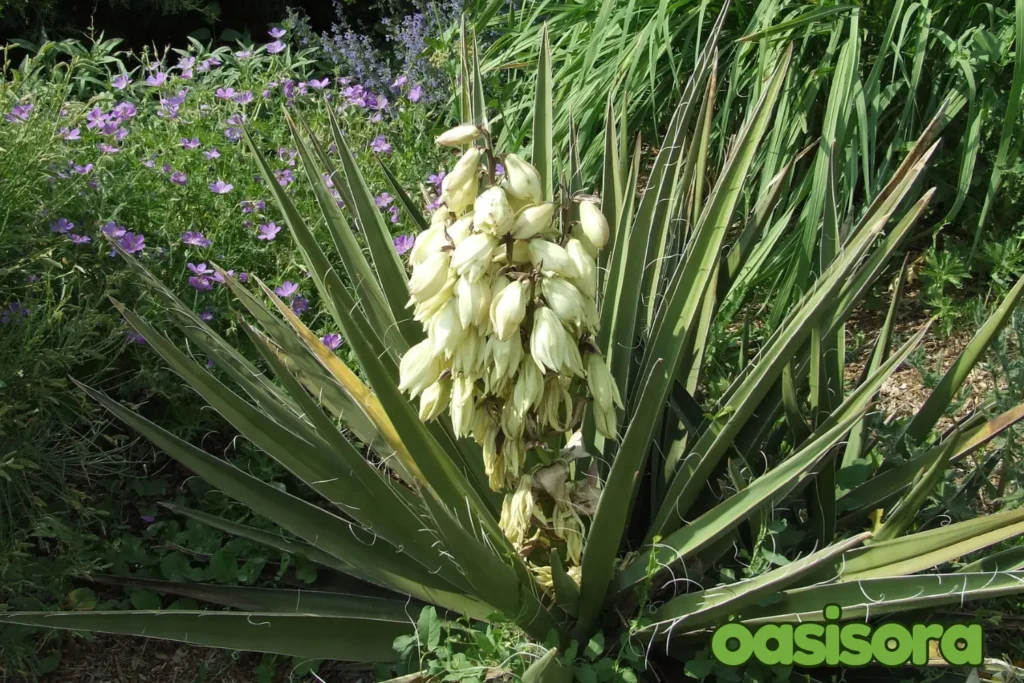
Yucca Plant
Due to the wide variety of Yuccas, they are available for all kinds of climates; some particularly grow well even with temperatures below freezing. Their simple, rigid leaves have spikes that resemble a pointed tip. Growing yuccas is sometimes too easy, since they may tend to extend out beyond the first single rosette.
Such sturdy plants include species without stems, trees that are 1-2 feet tall and broad, and also tall-stemmed trees with a collection of spikey leaves on the highest point. The massive, spineless yucca, Yucca elephantipes, may be grown in containers as well as in the ground.
Suitable succulents are necessary for a healthy and simple-to-maintain garden. When it comes to choosing individual species for your space, factors such as the type of soil, exposure to direct light, and climate-like conditions contribute to the optimal combination of plants.
Select plants based on your natural consistency, such as aloe or echeveria for hot, sandy places, and tough succulents like agave or sedum for cold regions.
Creative Outdoor Succulent Garden Ideas
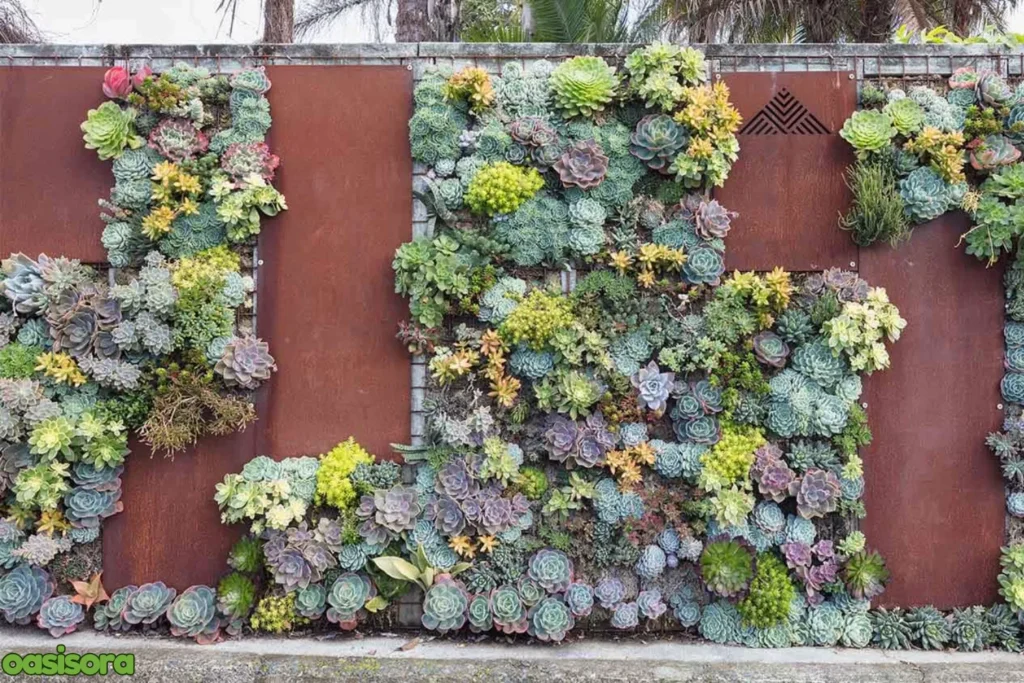
Creative Outdoor Succulent Garden
There are numerous decorating possibilities for outdoor succulent gardens, helping you to create an interesting and simple environment. Succulents may be planted in a variety of creative manners to improve your outdoor area, from hanging gardens to natural rock arrangements.
Let’s discuss some wonderful strategies below:
Vertical Succulent Garden
Use recycled wooden pallets, robust hanging pots, or amazing wall-mounted planters to build a fascinating vertical succulent garden. This is an awesome way to add plant life to garden walls or fences while maximizing space. For a streaming look, use trailing succulents like String of Pearls.
Succulent Rock Garden
Plant succulents in a rock garden to produce a desert-like, rustic setting. Combine tolerant of dry conditions desert plants like sedum and agave with large rocks and gravel. Besides improving the drainage system, rocks create an attractive focal point for the succulents’ soft textures.
Succulent Fountain Garden
Create a unique succulent container from an outdated or unused fountain. Use effectively drained soil and layer several plant varieties on every level. This creative approach delivers an exciting twist to your yard while reusing old items.
Container Succulent Gardens
Container gardening is a wonderful idea for terraces, narrow balconies, or other restricted areas. Plant different types of succulents in pots, wooden cases, or transformed containers. For an outstanding arrangement, combine various colors and sizes.
Succulents and Water Features
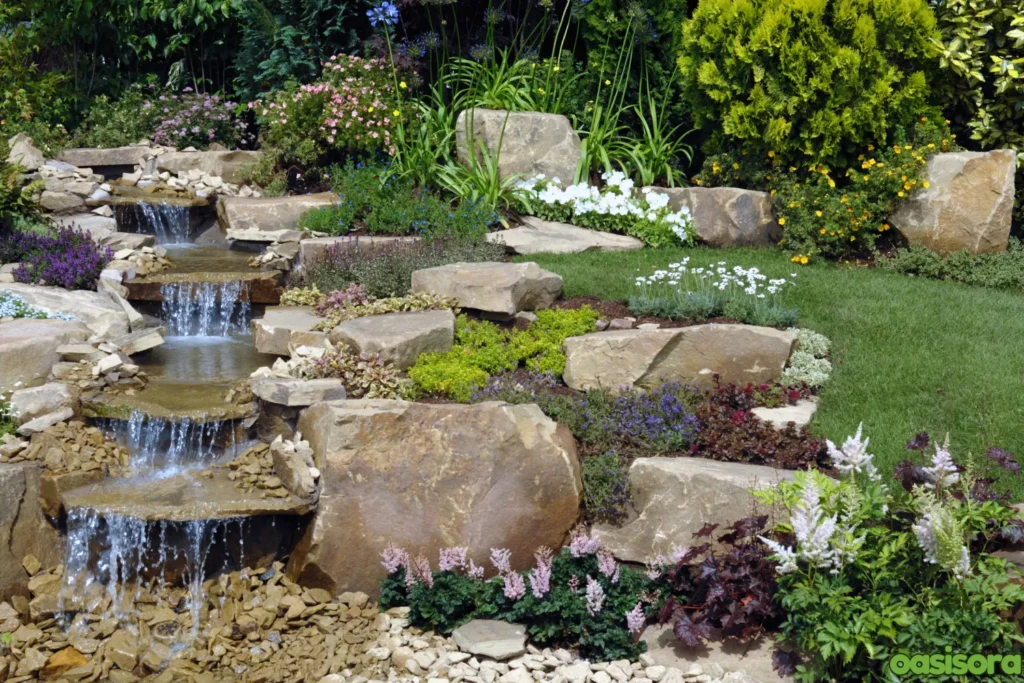
Succulents and Water Feature
For an impressive use of outdoor succulent garden ideas, combine succulents with water elements such as garden fountains or ponds, like tiny reservoirs. Prioritize aquatic-loving species that flourish well in humid environments, such as Crassula. This arrangement of textures increases your garden’s overall appearance.
Design Tips for Outdoor Succulent Gardens
A thoughtful design helps to create a beautiful outdoor succulent garden with unique architecture. The right elements help you to build a stunning and well-maintained space that can thrive for years. Let’s have a look at some amazing design tricks for your garden.
Grouping Succulents by Size and Color
Put smaller rosettes, like Echeveria, in the front and taller plants, like agave, toward the back of the scene. To provide depth and contrast, arrange succulents according to their height and color. Combine various hues, such as rich reds or purples, with silvery blue for an elegant look and to increase beauty.
Incorporate Textural Plants
Combining plants that have numerous characteristics creates an engaging atmosphere in your garden’s textures. Mix spiky plants like Senecio with succulents like Kalanchoe that have smooth, meaty leaves. This texture contrast reduces a dull appearance and improves the garden’s visual appeal.
Add Natural Elements like Stones or Pebbles
Place hardscaping elements like stones, pebbles, or rocks to provide a natural look and improve drainage of your space. Additionally, they are the decorative elements of outdoor succulent garden ideas that offer depth to the overall layout by increasing visual interest with the succulents’ soft leaves.
Succulent Garden in Raised Beds
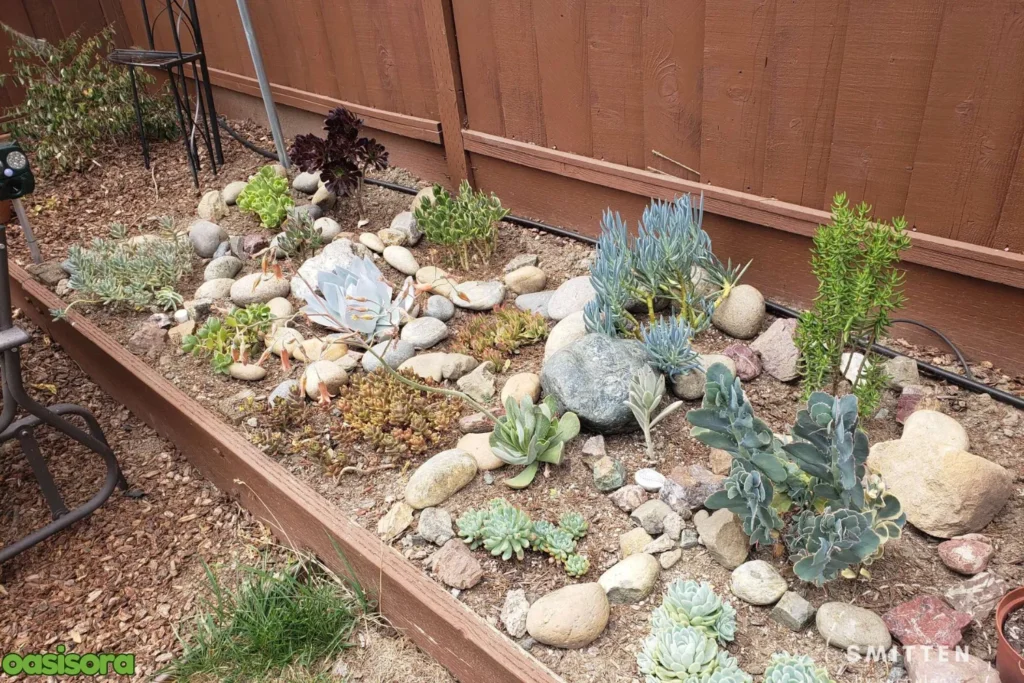
Succulent Garden in Raised Bed
In wet regions, raised beds promote drainage and assist in preventing waterlogging. They preserve succulents from bugs while making soil management easy. All these steps help to grow succulents quickly in their optimal environment. They also serve as a decorative element in your surroundings and boost productive plant growth all through the year.
Outdoor Succulent Garden Decor Ideas
These evergreen plants are adaptable to any environment and embellish any space with their colorful hues, varieties, and low maintenance. No matter how big or small your garden is, succulents can be used with great effectiveness in your landscaping in a variety of ways. These tips perfectly guide you in creating a practical yet beautiful outdoor safe place.
Incorporating Garden Sculptures or Ornaments
For practicality of outdoor succulent garden ideas pair up succulents with garden sculptures or ornaments to deliver your outdoor space charm and creative flair. Consider sleek metal sculptures or simple stone elements for creating a modern trend, and mix them with geometric-shaped plants.
Use old stone or wood sculptures for a natural look, and encircle them with robust succulents like sedum or jade. A mix of textures gives you a harmonious and eye-catching garden design that feels both organic as well an organized place.
Using Succulents to Line Walkways or Driveways
Succulents creeping across your driveways or walkways are a low-cost way to add a variety of colors to your outdoor passages. For a rich, even edge, consider low-growing types like creeping thyme or ground-covering Sedum.
Mixing different colors can lead to an exciting effect, such as that of rich Crassula reds with yellow hues. Arrange lovely stones or gravel in between to highlight the inherent plant’s beauty and provide a tidy, clean edge for your ways.
Install a Succulent Living Wall
Modify any simple, upright surface into a lush, green focal point with a succulent living wall. These plants with various sizes, shapes, and shades exhibit a colorful show via wall-mounted pots or vertical garden screens.
Combine tall succulents such as aloes with trailing succulents such as string of pearls for a stunning effect. Such a wall provides the vertical element to your outdoor space and may even supply greenery in areas like patios or balconies with limited breathing space for outdoor plants to thrive well.
How to Maintain an Outdoor Succulent Garden?
With the right understanding of how to care for your plants, involving the soil you need, watering habits, and sun exposure can keep your succulent garden healthy and strong. Plan for right and deep waterings to avoid rot, then let the soil dry out completely before watering again.
Use an appropriate soil for better water flow by combining regular potting soil with the rock mineral perlite or sand. Provide 6 to 8 hours of direct sun each day for sun-loving succulents, but go easy on particular varieties of succulents needing a bit of afternoon shade in warm areas.
With a little effort and outdoor succulent garden ideas, your plants will thrive, and your garden will remain vibrant for the year ahead.
Succulents for Different Climates
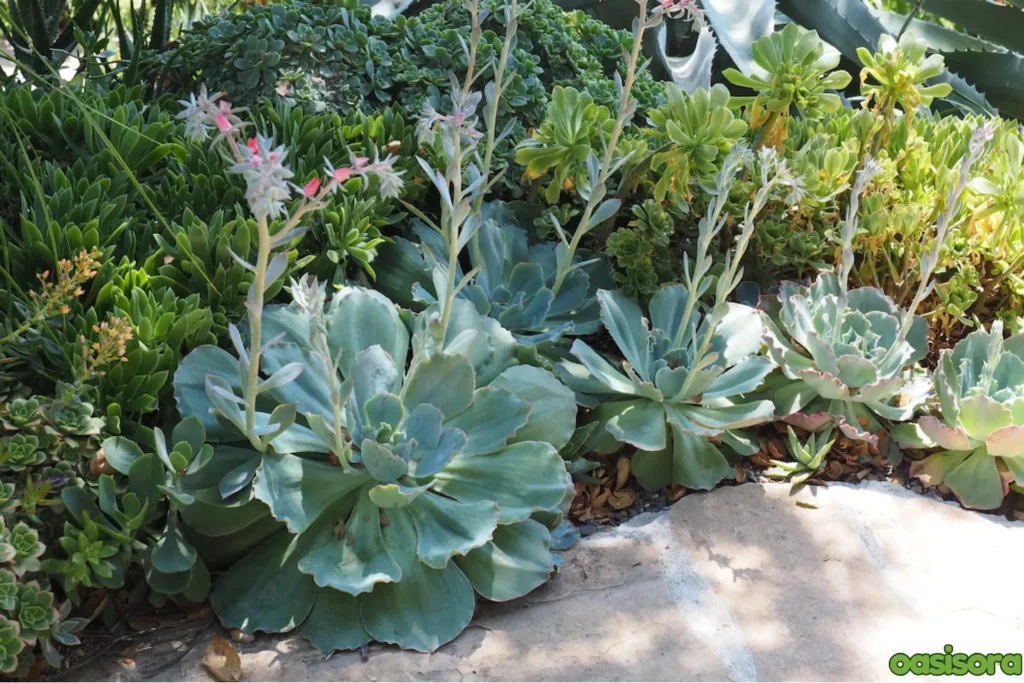
Succulents for Different Climates
Succulents have numerous types that can prosper in different environments. Pick the right type according to the hot or cold region and enjoy your healthy and beautiful garden throughout all seasons.
Cold-Climate Succulent Gardens
Winter hardy succulents such as Sedum, Sempervivum (commonly known as hens and chicks), and some varieties of Echeveria are resistant to frost and can freeze. These succulents thrive in raised garden areas or pots, preventing frozen ground effects, and they endure moderate frost.
Hot, Dry-Climate Succulent Gardens
Yucca, agave, and aloe are examples of succulents with low water requirements and are well-suited to hot and arid environments. These plants prefer full light and less moist soil, and they are also resilient to dehydration. They live happily in harsh conditions where other plants are at risk because of their thick, firm leaves, which retain moisture.
Container Gardening with Succulents
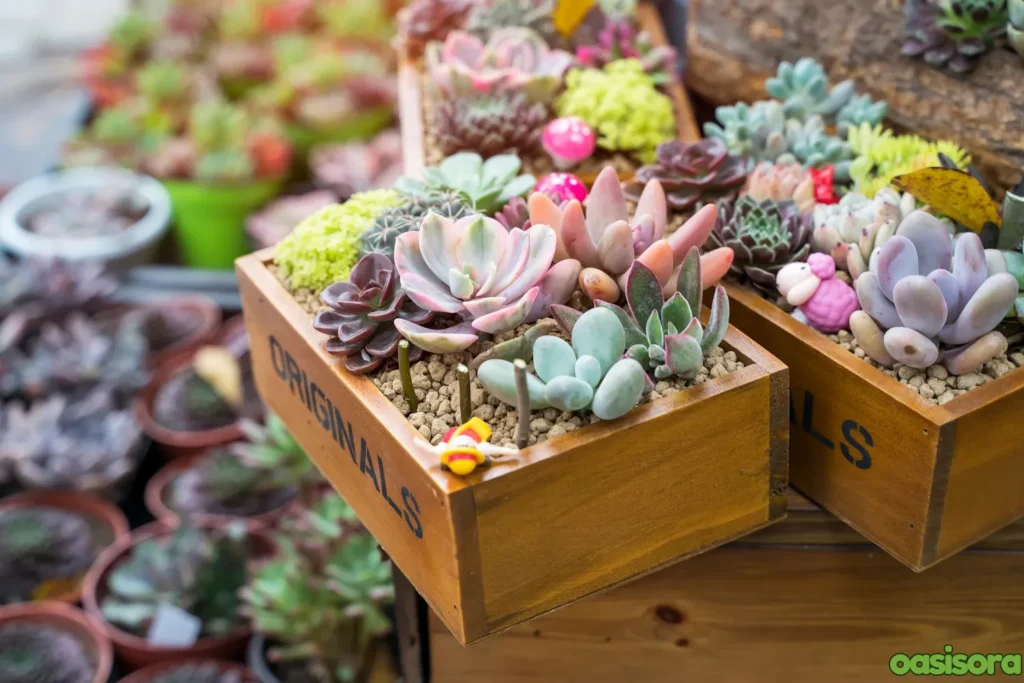
Succulents container gardening
Container gardening assists you in representing your succulents with flexible designs and placement. It perfectly covers your small spaces, portable garden options, or patios. Appropriate container arrangement creates a wonderful and thriving succulent landscape.
Choosing the Right Pots
To prevent damp roots, you need to choose pots that have enough room for drainage. Clay and terracotta pots are good choices because they are porous and allow for better airflow and water penetration.
Plastic pots might hold too much moisture, so stay away from placing them until they have holes for drainage. Think of using metal, ceramic, or stone planters to add valuable outdoor succulent garden ideas and increase the grace of your decor, but consistently make sure they drain efficiently.
Grouping Succulents in Containers
Combining multiple containers results in a gorgeous display that highlights the unique beauty of various succulents through an amazing arrangement. To add a pleasing appearance, combine different colors, sizes, and shapes to deliver a pleasing effect.
While trailing succulents can fill the sides of shorter pots, tall forms like agave give a better impression in the center point. To provide a layering effect and boost the beauty, cluster the containers at different heights by utilizing various planters and stands.
DIY Outdoor Succulent Garden Projects
Employing DIY projects for your outdoor area allows you to introduce personal preferences and distinct charm to your garden. Whether you focus on terrariums or wreaths, these projects are full of fun, and perfectly showcase your plants.
1. Create a Succulent Terrarium
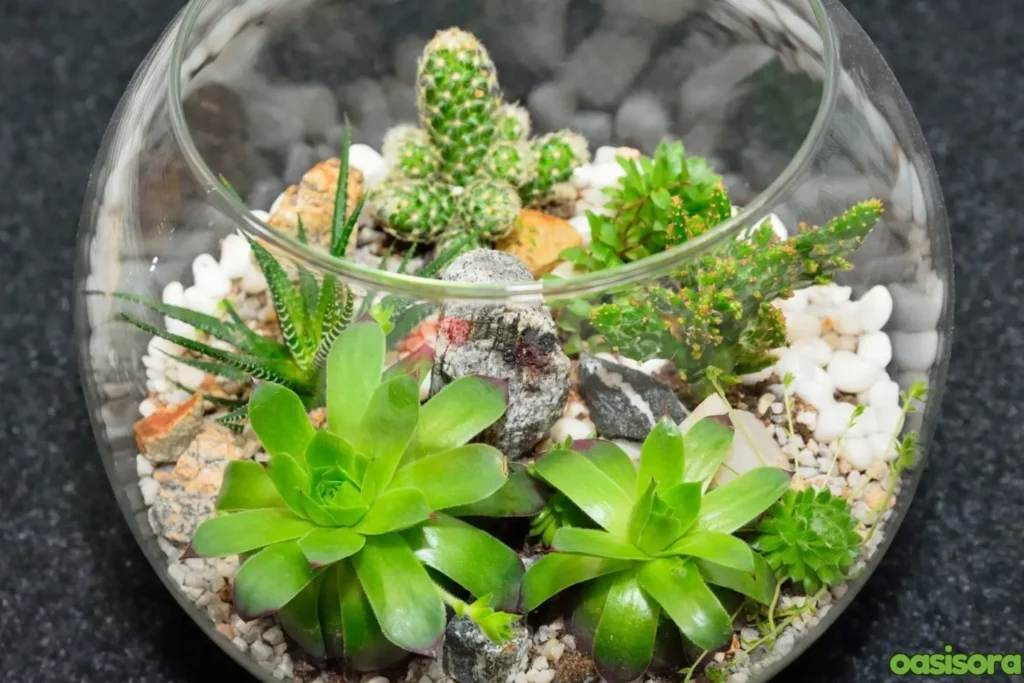
Succulent Terrarium
Initially, take a clear glass container, add a gravel layer for water flow, then put charcoal, gardening soil, and eventually the plants to form a succulent terrarium. The addition of sand or ornamental pebbles increases flair and grace. To preserve the terrarium from heat damage, place it in a sunny area but put it away from the strong midday sun. To prevent dampness formation, verify that the terrarium is open or has a ventilated lid.
2. Build a Succulent Tabletop Garden
Fill drained soil in a shallow pot to develop a succulent tabletop garden. Spread multiple types of succulents featuring various tones and textures, while moss or decorative pebbles show extra creativity. A little maintenance will keep this plain centerpiece fresh and add energy to your outdoor dining space with gorgeous looks for months.
3. DIY Succulent Wreath
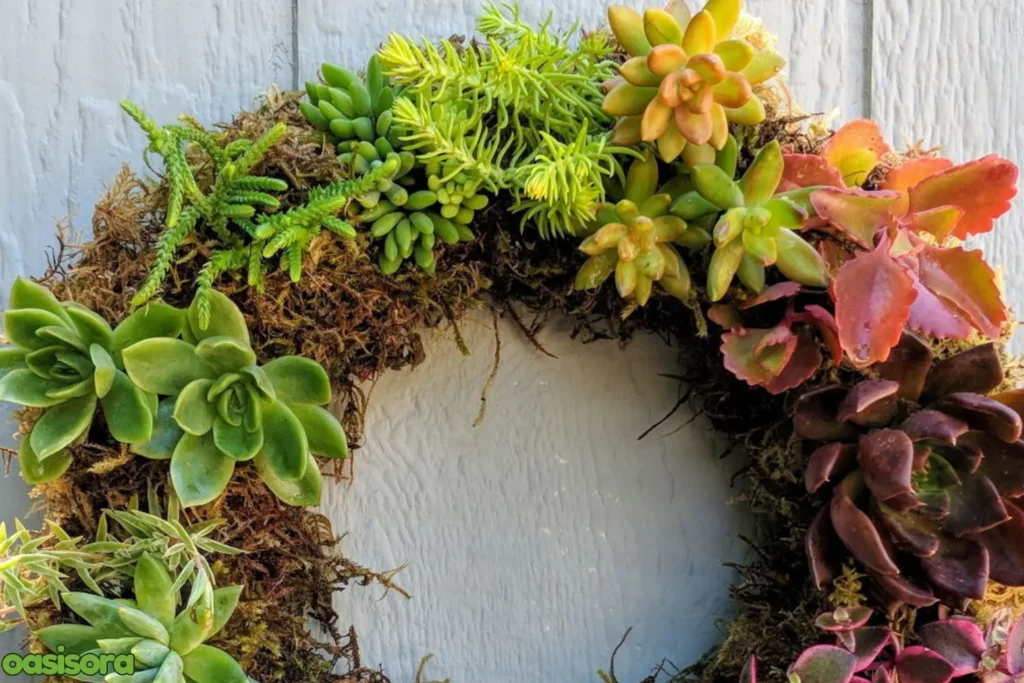
DIY Succulent Wreath
Affixing the wire framework to a durable support, like a moss ring, is the primary step to constructing a succulent wreath. Thoroughly stick or connect the succulents to their position, verifying that they are evenly distributed around the wreath. After completing the process, place the wreath in a well-ventilated, shady exterior location where it will grow nicely with little care while offering an attractive touch to your yard or porch.
Advanced Succulent Garden Features
If you are looking to upgrade your garden, then advanced features with significant outdoor succulent garden ideas increase both the usability and look of your area. Combining items like creek beds and pairing succulents with strong varieties will give you an eye-catching yard area.
Adding a Dry Creek Bed
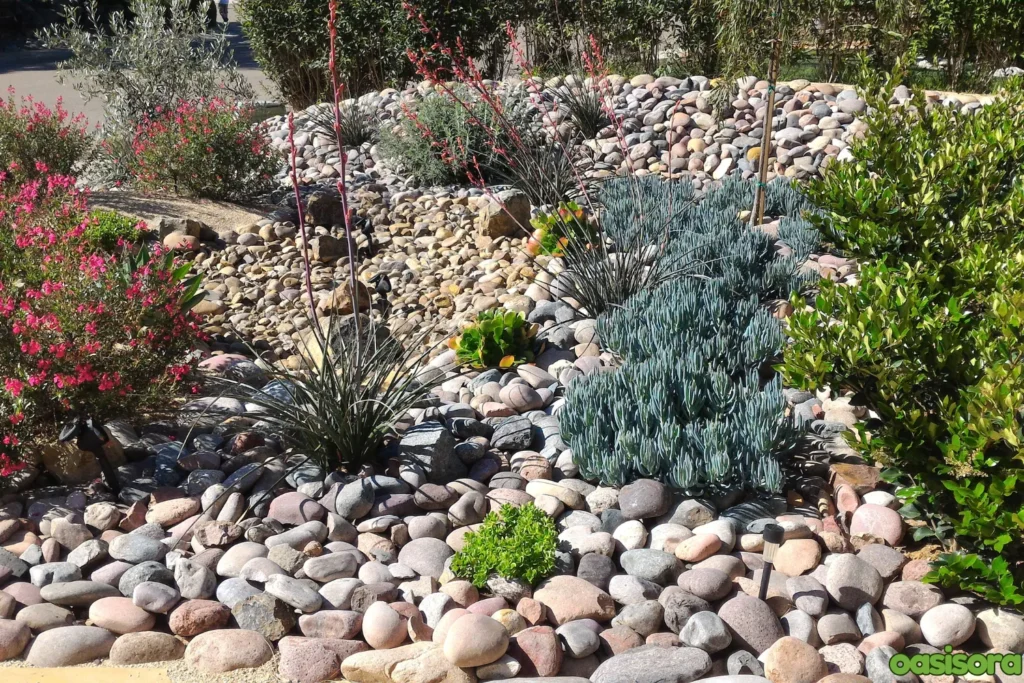
Dry Creek Bed for Succulents
A dry creek bed is an appealing feature in your succulent garden to modify your space. First of all, dig a shallow trench and cover it with garden fabric to prevent unwanted weeds. For the construction of the bed’s architecture, cover the trench with gravel or several kinds of river rocks.
Then, for a circulating, organic look, set up low-growing succulents like Crassula or Sedum along the edges, permitting them to overflow. This component improves drainage and requires minimal maintenance while resembling a stream.
Perfect Pairing of Other Drought-Tolerant Plants with Succulents
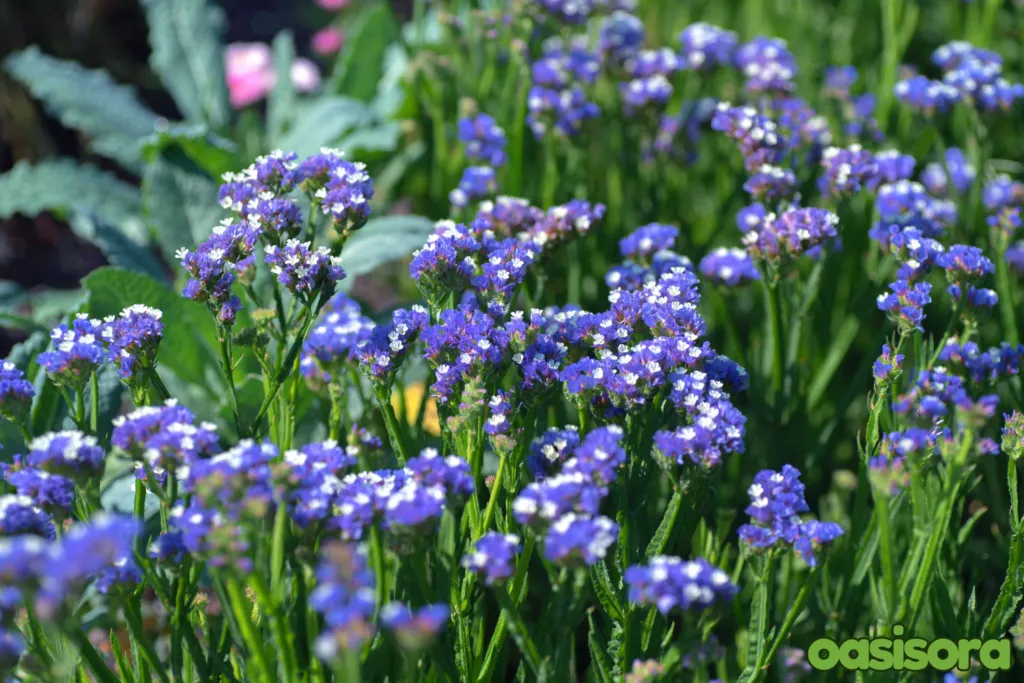
Beautiful lavender plants
Various arid plants like Unique ornamental grasses, beautiful lavender plants, or rosemary are an ideal match with succulents to build a lovely and low-maintenance landscape. These plants form a useful combination as they have identical needs for sunlight and water. Their union generates a range of hues and textures while conserving water and cutting the extent of watering.
Environmental Benefits of Succulent Gardens
Due to their low moisture requirement, succulent landscapes are environmentally friendly in drought-risk zones. Also, their deep root networks protect the surface by stopping soil erosion. Since they attract insects, which invites regional diversity and enables the passage of a strong ecosystem. Thus, succulents are an environmentally friendly option for exterior landscapes.
Common Mistakes to Avoid in Outdoor Succulent Gardens
Setting up a well-organized succulent garden can be easy if you are aware of these pitfalls that can ruin your structure.
- Overwatering is a common mistake that boosts the root damage process. Succulents don’t require frequent watering so plan for an infrequent, thorough watering schedule.
- Selecting the Wrong Soil: They need optimal, rich nutrient soil. Soaked roots and slow growth can occur from applying heavy or moisture-retaining soil.
- Improper Placement: Most succulents require significant light exposure and perform best in direct sunlight. Poor drainage or unnecessary shade adversely affects plant development.
By avoiding these common errors, you can develop a prospering, easy-to-handle landscape that ensures your succulents stay healthy and vibrant for long.
Final Thoughts on Outdoor Succulent Garden Ideas
Creating an outdoor succulent garden is a pleasant option to add affordable maintenance and elegance to the region. Don’t be fearful of trying out multiple succulent layouts, artwork, and combinations to see the best option. The opportunities are unlimited, whether you’re going to make a peaceful desert-inspired landscape, an attractive succulent wall, or a unique container display.
Outdoor succulent garden ideas offer a distinctive look to your yard and promote creativity. So collect your materials, pick your plants, and go to design an incredible eco-friendly garden that symbolizes your individuality and goals.
FAQs
How frequently can I water my outdoor succulent garden?
Deep but occasional waterings and leaving the soil to dry out in between schedules are great for your succulents. Warm and drought regions need water every one to two weeks, and once a month in cold regions.
Which kind of soil is optimal for outdoor succulents?
Succulents swiftly grow in soil that drains properly; a blend of potting soil, sandy material, and gravel or perlite is best.
Can you grow succulents in a cool climate?
Yes, frost-hardy plants such as Sedum are favorable to low-temperate places. Prefer placing succulents indoors during periods of extreme cold and growing in raised beds or planters to avoid freezing.
Are succulents poisonous to pets?
Some succulents have poisonous leaves, including aloes and echeveria. So make sure the species in your garden are not dangerous, and take measures to keep pets away from them.
